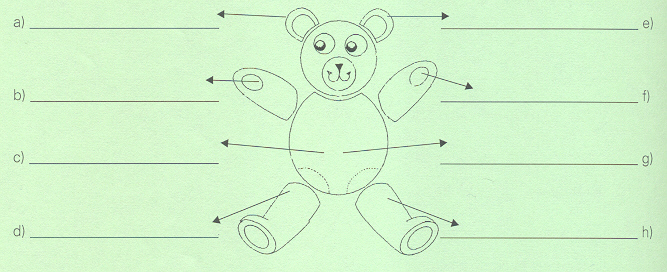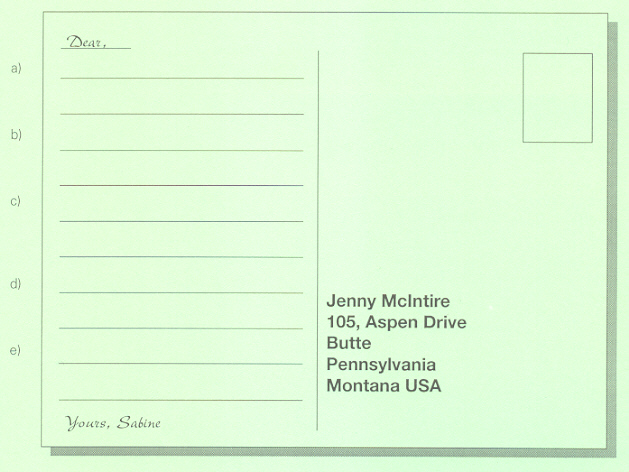
Prüfungsaufgaben Englisch Hauptschulabschluss 1998
Erweiterte Textaufgabe
Bears in Houses
There is a kind of bear which you can play with as much as you like and it will not bite you. And it doesn't need any food or drink! All over the world you can find millions of these bears. Although there are so many of them, some bears are really expensive. They are teddy bears. How did the teddy bear get its name? Teddy bear experts think the name goes back to Theodore Roosevelt who was President of the United States from 1901 to 1909.
In 1902 President Roosevelt went on a journey around the USA. Some people organized a hunting trip for him. They tied a young bear to a tree with a rope. Roosevelt thought that this was not real hunting and he didn't shoot the bear.
All the newspapers printed the story and there was a funny picture of Roosevelt with the bear. After that, the Washington Post newspaper always printed a small bear with each article they wrote about the President. The bear soon was a symbol for Roosevelt and Roosevelt's nickname "Teddy" (for Theodore) was also given to the bear. Soon toymakers got interested in the idea and toy bears became a popular present for kids and even adults. Some of these old toy bears are very expensive and today you can pay anything between 100 and 1000 dollars for an old "Teddy".

1. Questions on the text. Write full sentences.
a) Why is it easier to have a teddy bear than a pet?
b) What did some people do when Roosevelt was on a journey around the USA?
c) What did Roosevelt think when he saw the helpless bear?
d) How did the bear become a symbol for Roosevelt?
e) Why is the toy animal called teddy bear?
2. Find the words in the text.
a) Persons who know a lot about something are
b) Someone who is head of a government is
c) People who are older than eighteen are
3. Give a definition of the following words:
a) a newspaper
b) a journey
c) to print
4. Fifteen-year-old Sabine is a German school girl. At the moment she is spending a year at a school in Washington, D.C. She likes making teddy bears very much.
Do you know the names of these parts?

5. Eines Tages stellt Sabine einem Reporter der Washington Post einige Fragen über Roosevelt. Schreibe ihre Fragen auf Englisch!
a) Wo wurde Roosevelt geboren?
b) War Roosevelt ein guter Präsident?
c) Wer machte das Foto von Roosevelt und dem Bären?
d) Wie lange dauerte Roosevelts Reise durch die USA?
6. Fill in the correct word.
|
something/anything some/any someone/anyone somewhere/anywhere |
Together with his friend Debbie, Tom is looking for a birthday present for Sabine. They are in a big department store.
|
a) |
Debbie: |
"Look, they have _______ nice toys here." |
|
b) |
Tom: |
"Toys? Sabine isn't a child. You can't buy her _______ toys." |
|
c) |
Debbie: |
"That's not right. She has a very nice collection of toy animals. A teddy bear is _______ she would like." |
|
d) |
Tom: |
"But teddy bears are so expensive. _______ else should buy her a teddy bear, her mother for example." |
|
e) |
Debbie: |
"No, we should do it. Let's look for a cheaper one _______ else." |
7. Bei der Geburtstagsparty bedankt sich Sabine für ihr Geschenk. Übersetze ihre Aussagen.
a) "Dieser Teddybär ist großartig."
b) "Ich mag Spielzeugtiere lieber als Haustiere."
c) "Vor drei Jahren begann ich Teddybären zu sammeln."
d) "Teddybären brauchen nicht alt zu sein. Neue Bären sind auch schön."
8. Fill in the verbs in their correct form.
A week later Tom is talking to his mum about the birthday party.
a) Last week we ______ (to buy) a teddy bear for Sabine.
b) It _______ (to be) a big success.
c) She _______ (to carry) it around with her every day.
d) She says, she _______ never _______ (to have) such a nice little bear.
e) At the moment she _______ (to look) for a second one.
f) I think I _______ (to go) to the shops with her tomorrow.
9. Write Sabine's answer to this advert.
|
a) |
- read - advertisement |
|
|
b) |
- want to be penfriend - interested in |
|
|
c) |
- send photo - 25 teddies |
|
|
d) |
- know story - Roosevelt - teddy bear |
|
|
e) |
- hear soon |

Pauker Hauptschule Klasse 9; Stephan Hutt Verlag, Stuttgart, 1999/2000, Seite 127 - 131